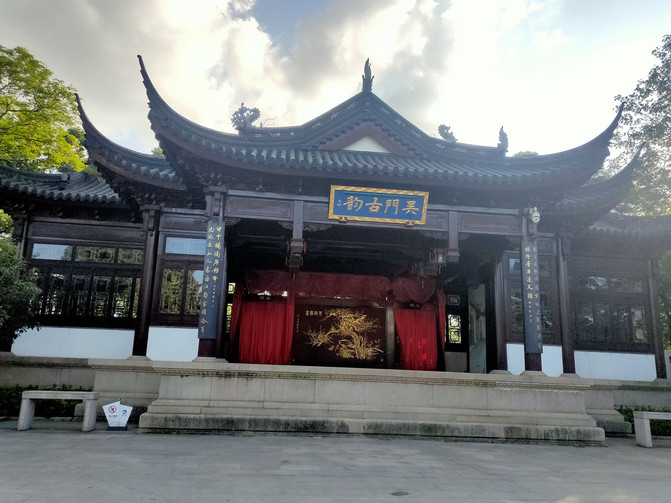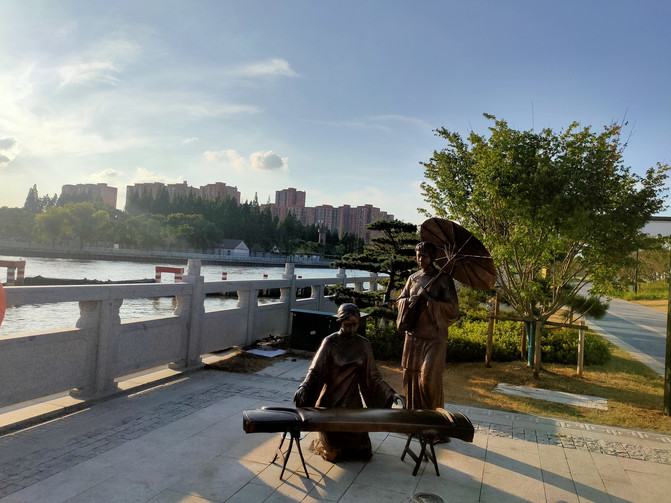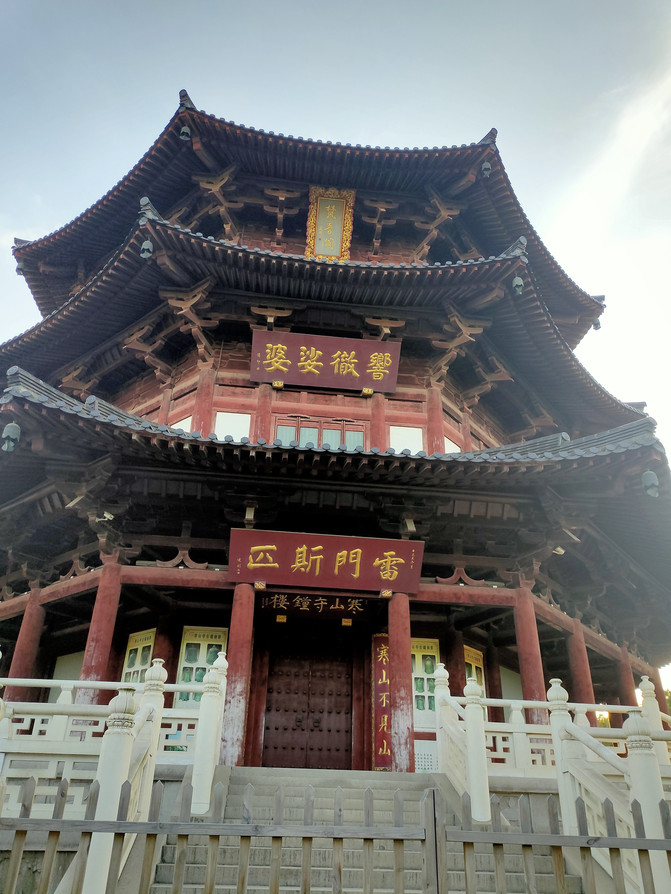Maple Bridge berthed at night, ancient port of canal
★ Tourist location: Suzhou Fengqiao Scenic Area
Coming out of Guanqian Street, we divided into two groups, one way to Humble Administrator's Garden, and the other way to Fengqiao Night Park. Hanshan Temple is not very interested, but I still want to visit the Maple Bridge that Zhang Ji wrote about.
Suzhou is the city with the most rivers and bridges in China. The development of this city's style and temperament are closely related to water. "Small bridges and flowing rivers, people" is a true portrayal of Suzhou City. Who can say that the gentleness in the bones is not given by water? People gathered along the river and gradually became the "first-class rich and romantic place in the red world" praised in Dream of the Red Chamber. Yes, not only wealth, but also romance. Many literati and literati left their literati in Suzhou and praised it as a paradise on earth.
The Grand Canal flows through this ancient city, and people gather along the river, gradually forming a unique water city culture. It is not only the ships sailing on it that rely on the current to guide the direction of progress, but also Suzhou, a city that relies on water for a living. It can be said that without the Beijing-Hangzhou Grand Canal, the development of Suzhou and even the entire Jiangnan region would be greatly restricted. Even though modern transportation has developed enough to include planes, trains, and cars, the waterway transportation of the Beijing-Hangzhou Grand Canal is still very busy.
When I came here in the past, the bridge where Jinghong Ferry was not walkable. This time, I was pleasantly surprised to find that this nameless arch bridge was actually walkable. Climb the bridge and find a vast canal on one side. Because Jiangxinzhou ends here, the view out is very wide and the river has become wider. On the other side are Maple Bridge and Hanshan Temple. The sky is high and the clouds are clear, and the towers are tall.
Walking through the bridge, you will find a relatively open space. There is a group of sculptures beside the river. A woman is kneeling and playing the piano, which seems to be in the style of a guzheng. Next to her, there was another woman holding a paper umbrella. I originally thought this woman should be the maid of the person who stroked the Zheng, but seeing that the person's umbrella was for me, she was no longer Miss's maid. I don't know what her identity was.
There is an introduction to "Falling into the water and listening to the sound" next to it. It seems that another attraction is about to be built here. The shape has been roughly completed, but there are still a large number of plants to be planted later. There may be a road leading to the gate of the scenic spot from here in the future, but the road is not open yet, so we can only still return from Fengqiao Scenic Area.
In the end, I still had to go to the Great Poetry Monument to make a card. It rained heavily last time and time was too tight, so I took a few quick glances and left. This time there was plenty of time, and the sun was setting in the west, and the big poem stele looked particularly tall and majestic in the afterglow of the sunset. The total height of the poem stele is 16.9 meters and weighs about 400 tons. The front is engraved with "Mooring on Maple Bridge at Night" by Zhang Ji of the Tang Dynasty: "The moon sets, the dark cries and the frost fills the sky, and the river maple and the fishing fire are mourning. Hanshan Temple outside Gusu City, the passenger ship arrives at midnight." This poem was written in calligraphy by Yu Yue. Yu Yue was a scholar, litterateur, scholar, ancient philologist, and calligrapher in the Qing Dynasty. He was born in Deqing County, Zhejiang Province. He was a scholar in the 30th year of Daoguang in the Qing Dynasty and was a member of the Hanlin Academy. The modern poet Yu Pingbo is his biological grandson, and Zhang Taiyan and Wu Changshuo are his students. He was appreciated by Emperor Xianfeng and allowed Henan to study politics. Later, he was dismissed from office and moved to Suzhou, where he devoted himself to academic studies for more than 40 years.
In the thirty-second year of Guangxu of the Qing Dynasty, when Jiangsu Governor Chen Kuilong rebuilt Hanshan Temple, he asked Yu Yue to write in calligraphy the stone tablet "Maple Bridge Night Mooring". This is the third "Maple Bridge Night Mooring" in the history of Hanshan Temple. The first two pieces were written by Wang Si of the Song Dynasty and Wen Zhengming of the Ming Dynasty respectively, and they were lost because of their long age. Yu Yue not only wrote a poem, but also left a footnote: "Tang Zhang Ji's poem" Mooring at Night on Maple Bridge "is very popular, but the next sentence is quite suspicious..." He made a textual research on the poem and explained the reason for writing the monument. When he wrote this poem, Yu Yue was already eighty-six years old, but he was skilled, had a steady composition, and had a deep and round meaning. The whole poem was dripping and in one go. Three months after writing it, the old man passed away.
On the back of the big poem stele is the "Prajna Paramita Heart Sutra" written by Qianlong's imperial pen. The entire scripture has only one volume, with a total of 260 words. It belongs to a section of the more than 600 volumes in the "Da Pin Prajna Sutra". The original text is Sanskrit. When it comes to Emperor Qianlong, he left many calligraphy treasures, so imperial calligraphy and anything are not too rare. However, he likes to write poems and inscriptions, and this is the first time he has seen the full text of the "Heart Sutra". The emperors of the previous generations of the Qing Dynasty all had deep attainments in Sinology and high attainments in Buddhism. It is said that his great-grandfather, Emperor Shunzhi, became a monk in Wutai Mountain after the death of Concubine Dong E. His father, Emperor Yongzheng, worshipped Buddha all year round, although in legend this emperor killed heavily. Even though Emperor Qianlong was not deeply attainments in Buddhism, he was familiar with several common Buddhist scriptures.
Standing under the big poem stele and looking up at the blue sky, I feel even more insignificant. Compared with "Heart Sutra", I prefer "Maple Bridge Night Mooring". Although Qianlong always thought that his calligraphy was very good, otherwise he would not have left ink everywhere. But as the saying goes, there is no harm if there is no comparison. Comparing the two, the difference will be obvious. After all, he is a famous calligrapher. This poem is written with great vigor and makes people feel content when reading it.









































Previous Article:Baima River Longchi, an indissoluble bond with Little Bailong (Part 1)
Next Article:Jiangsu Tourism: Entering Tongli Ancient Town, Charming Water Town (Photo)
